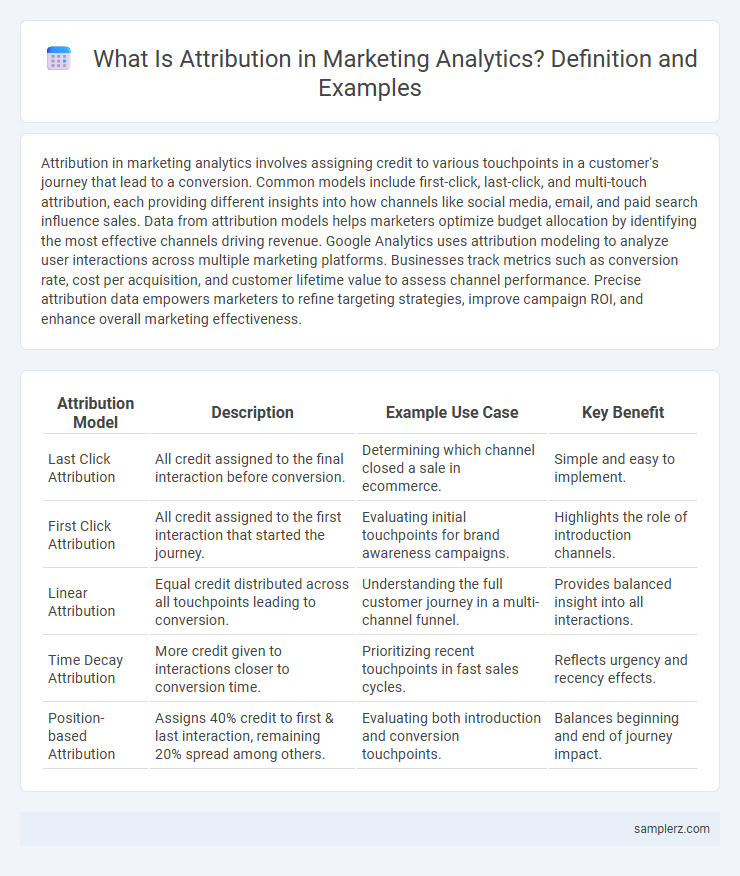Attribution in marketing analytics involves assigning credit to various touchpoints in a customer's journey that lead to a conversion. Common models include first-click, last-click, and multi-touch attribution, each providing different insights into how channels like social media, email, and paid search influence sales. Data from attribution models helps marketers optimize budget allocation by identifying the most effective channels driving revenue. Google Analytics uses attribution modeling to analyze user interactions across multiple marketing platforms. Businesses track metrics such as conversion rate, cost per acquisition, and customer lifetime value to assess channel performance. Precise attribution data empowers marketers to refine targeting strategies, improve campaign ROI, and enhance overall marketing effectiveness.
Table of Comparison
| Attribution Model | Description | Example Use Case | Key Benefit |
|---|---|---|---|
| Last Click Attribution | All credit assigned to the final interaction before conversion. | Determining which channel closed a sale in ecommerce. | Simple and easy to implement. |
| First Click Attribution | All credit assigned to the first interaction that started the journey. | Evaluating initial touchpoints for brand awareness campaigns. | Highlights the role of introduction channels. |
| Linear Attribution | Equal credit distributed across all touchpoints leading to conversion. | Understanding the full customer journey in a multi-channel funnel. | Provides balanced insight into all interactions. |
| Time Decay Attribution | More credit given to interactions closer to conversion time. | Prioritizing recent touchpoints in fast sales cycles. | Reflects urgency and recency effects. |
| Position-based Attribution | Assigns 40% credit to first & last interaction, remaining 20% spread among others. | Evaluating both introduction and conversion touchpoints. | Balances beginning and end of journey impact. |
Understanding Attribution in Marketing Analytics
Marketing attribution assigns credit to various touchpoints in a customer's journey, such as email campaigns, social media ads, and organic search, providing insights on their effectiveness. Multi-touch attribution models, including linear, time decay, and position-based, offer nuanced analysis by distributing conversion value across multiple interactions. Understanding these models in marketing analytics helps optimize budget allocation and improve campaign performance by identifying the most impactful channels.
Common Types of Attribution Models Explained
Common types of attribution models in marketing analytics include last-click, first-click, linear, time decay, and position-based models. Last-click attribution assigns full credit to the final touchpoint before conversion, while first-click attributes success to the initial interaction. Linear models distribute credit equally across all touchpoints, time decay emphasizes recent interactions, and position-based models allocate more credit to the first and last touchpoints.
Real-World Examples of Attribution in Analytics
Multi-touch attribution models track customer interactions across channels such as social media, email campaigns, and paid search to assign value to each touchpoint. For instance, e-commerce brands use attribution analytics to identify that 40% of conversions stem from Instagram ads followed by email nurtures, enabling precise budget allocation. Google Analytics' data-driven attribution found that 30% more conversions occurred when optimizing for assisted conversions in a SaaS company's marketing funnel.
How First-Touch Attribution Impacts Campaign Decisions
First-touch attribution assigns full credit to the initial interaction, influencing marketers to prioritize channels that generate first contact, such as social media ads or search engine results. This approach can lead to increased investment in awareness campaigns and budget allocation toward top-funnel activities that initiate customer journeys. Analyzing first-touch data reveals which campaigns effectively attract new prospects and helps optimize strategies for lead generation.
Last-Touch Attribution: Use Cases and Limitations
Last-touch attribution credits the final interaction before conversion, making it ideal for analyzing the impact of last-step marketing channels such as email campaigns or retargeting ads. It provides clear insights into which touchpoint closed the deal but often overlooks the role of earlier engagements in nurturing leads. Marketing teams must balance its simplicity with the risk of undervaluing multi-channel contributions to optimize budget allocation effectively.
Multi-Touch Attribution in Modern Marketing Strategies
Multi-touch attribution in modern marketing strategies assigns value to every customer interaction across various channels, including social media, email, and paid search, to identify the most effective touchpoints. Analytics platforms like Google Analytics 4 and Adobe Analytics enable marketers to track these interactions and allocate budget based on data-driven insights. This approach enhances campaign ROI by optimizing spend on high-impact channels and improving customer journey understanding.
Implementing Data-Driven Attribution Models
Implementing data-driven attribution models in marketing analytics allows businesses to accurately identify the impact of each customer touchpoint on conversion rates, using machine learning algorithms to analyze user behavior across channels. This approach enhances budget allocation by quantifying the contribution of channels like paid search, social media, and email marketing, optimizing campaigns for higher ROI. Companies leveraging platforms such as Google Analytics 4 or Adobe Analytics can integrate first-party data to refine attribution accuracy and drive data-backed marketing strategies.
Comparing Attribution Examples Across Channels
Attribution in marketing analytics evaluates the impact of channels such as social media, search engines, and email campaigns on conversion paths. For instance, last-click attribution credits the final touchpoint before purchase, often highlighting paid search, while multi-touch attribution distributes credit across all interactions, including display ads and organic search. Comparing these models reveals how different channels contribute to sales, informing budget allocation and strategy optimization.
Tools and Platforms for Attribution Analytics
Google Analytics offers robust attribution modeling tools that help marketers assign credit to various touchpoints in a customer journey, enhancing campaign performance insights. Adobe Analytics provides customizable attribution features enabling detailed analysis across multi-channel marketing efforts for better budget allocation. Attribution platforms like HubSpot and Adjust integrate seamlessly with CRM and ad networks, delivering comprehensive data to optimize conversion tracking and marketing ROI.
Best Practices for Attribution in Marketing Analytics
Using multi-touch attribution models enables marketers to accurately assign credit to various touchpoints throughout the customer journey, improving campaign effectiveness. Implementing data-driven attribution by leveraging machine learning algorithms helps optimize budget allocation based on real impact across channels. Regularly validating attribution models against actual sales performance ensures precise measurement and informed decision-making for marketing strategies.

example of attribution in analytics Infographic
 samplerz.com
samplerz.com